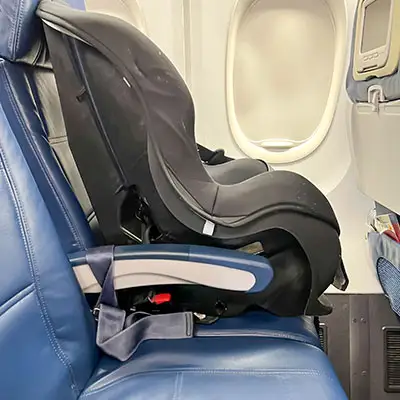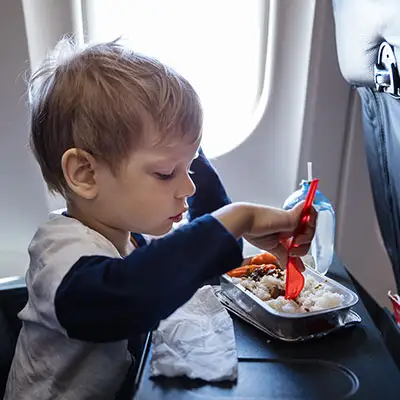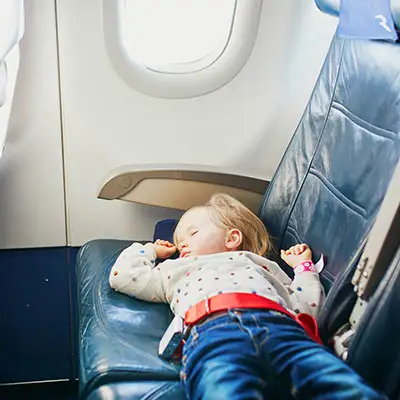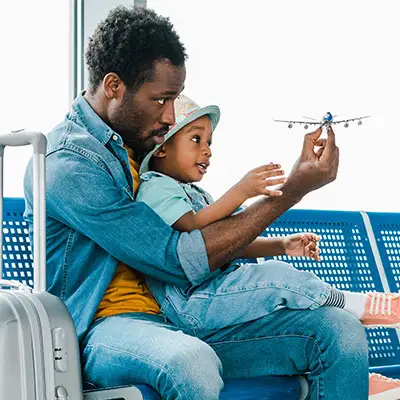When you’re trying to figure out how to fly with a family (without losing your sanity), who better to ask than a flight attendant and mom?
Seven Corners went straight to the expert to get the best tips for flying with kids.
Here’s what Victoria, a flight attendant for a major U.S. airline and mom to toddler, Maddy, had to say.
Flying with Kids: What to Do Before You Fly
Book direct flights & minimize stopovers.
When flying with kids, especially babies and toddlers, the fewer stops, the better. Whenever possible, purchase a direct flight so you don’t have to deal with additional headaches like rushing to make connecting flights, delayed layovers, multiple takeoffs, and increased risk of lost luggage.
Travel insurance can help protect you in many of those instances, but it doesn’t alleviate the stress at the moment when you’re trying to juggle a fussy baby, an overtired toddler, and wondering where your checked suitcase has gone.
If you can’t avoid a long-haul flight, our tips for handling long and connecting flights can help you prepare.
Consider buying a separate seat for your child.
Most families are traveling on a budget, but remember that there are different types of costs. In some instances, what you save in cash might cost you more in stress and inconvenience.
“If you’re traveling with a baby, if you can afford it, you want to buy a seat for them. Presumably, on the other end, you’re going to need a car seat,” said Victoria. "Your baby is more comfortable traveling in their car seat. They sleep really well there (compared to the airplane seat), and you don’t have to worry about holding the child the whole time.”
The appeal of not paying for a seat for a child under two years old is strong, especially if you’re flying at peak times like holidays and with the general increases in the cost of air travel. At least consider the trade-offs, though, before you decide.
“You’re not paying for it with dollars; you’re paying for it with a squirmy child in your lap,” said Victoria. "Then you get trapped because the baby’s asleep on your chest, and you’re like, ‘Well, now I can’t move.’ Maddy’s almost two. I would still love her to be in her car seat on the plane because it contains her; it’s a place she’s familiar with. We’re not reinventing the wheel every time we travel.”
Some airlines like United even provide free onboard bassinets. These are limited to business class passengers and those in economy on some international flights, but it’s certainly worth asking about.
United has an entire section on its website about traveling with children, including info about approved car seats and family boarding, that’s worth a quick read.
Reserve your seats in advance.
What if it's more than just you and your baby? Maybe you have more than one child or are bringing the whole family along. Pick your seats together, even if it means you have to pay a little extra to get assigned seating.
You can always ask the other passengers to trade, but as Victoria says, there's a certain risk in that.
“You're relying on the kindness of strangers or gate agents to switch you into seats all together, and sometimes you might not get that. Sometimes your five-year-old might be sitting somewhere else, not next to you.”
Especially when traveling with multiple young children, it’s just not worth the added stress or risk.
Choose an airline with kid-friendly perks.
Not all airlines are created equal. To make flying with kids go as smoothly as possible, try to book with a kid-friendly airline.
Here’s a quick list of airlines with kid-friendly perks.
Kid-friendliest airlines
- JetBlue: When you’re trying to leverage your frequent flyer miles, JetBlue’s TrueBlue is great for families. The program lets you combine up to seven people’s points. Imagine how quickly you can earn a free flight when the whole family is chipping into your miles total. If you’re worried about keeping your kids entertained before or during the flight, JetBlue has you covered there. Some of the airline’s terminals feature some pretty fantastic playgrounds to help your kids work out some energy. And with free in-flight Wi-Fi and personal TVs on each seat, no one has to share the tablet.
- Virgin America: Lavatories, regardless of the airline, are gross. Virgin America makes our list of kid-friendly airlines because its rear lavatories have diaper-changing stations. It’s cleaner and safer than balancing your baby on a seat or, worse, any surface in the bathroom. If you have kids under five, you also get priority boarding, and kids’ meals can be pre-ordered, perfect for when your future pilot will only eat chicken nuggets.
- Southwest Airlines: If you remember from the ads, “bags fly free.” That means that when you have extra gear because of your little one, you won’t break the bank checking it all. With Southwest’s Companion Pass, you also can snag even better deals on airfares for your mini travel buddy.
- Alaska Airlines: Flying with Alaska Airlines as a family has a unique advantage. The airline reserves a couple “family rows” for each flight, improving the chances of you being able to sit together. We’re also fans of how they provide a snack basket for kids shortly before landing. It's usually when kids fidget the most, so what better way to calm them down than with a little treat?
Reserve kids' meals in advance.
For long-haul flights where meal service is included, always reserve your kids’ meals in advance. Special meals are always served ahead of the regular meal service.
By reserving kids’ meals in advance, you’re ensuring your kids will be fed first, which allows you time to help them get set up and fed before your meal arrives.
Make sure their car seats are airline approved.
Before planning to use your car seat on the flight, make sure it is FAA approved so there are no surprises at the gate. The FAA does provide guidance on approved car seats and child restraints for anyone flying with children, so be sure to check before you fly.
Apply for TSA PreCheck or Global Entry.
To save time at security, it’s worth applying for TSA PreCheck. If your children are 12 and under, they can use the TSA PreCheck lane with you.
Check out Travel + Leisure’s quick guide to TSA PreCheck — and how it’s different from Global Entry — if you’re still on the fence about applying.
Download movies and shows ahead of time.
Make sure you load up your kids’ electronic devices with downloaded movies and shows to keep them occupied throughout the trip. This is a good idea even if the airline has in-flight TV or movies. You can never be sure what will be available and if those shows are kid-friendly.
Charge electronics and bring fully charged power banks.
Make sure your kids’ iPads, tablets, and phones are fully charged and you have back-up, fully charged power banks in your carry-on.
This will prevent the inevitable meltdown that comes with an episode of Bluey getting cut short by a prematurely drained battery.
Pack your kids' favorite snacks.
First on Victoria’s packing list is food.
“Bring all the snacks. Your child will turn into the hungriest person on the planet on the plane, and you’ll be stuck with pretzels and cookies, and they’re going to hate that.
"Even if we’re going on a short flight with Maddy — I flew from Dallas to Austin, which is a 45-minute flight — I packed a full meal and every easy snack I could think of. She basically ate all of it because you’re like, ‘I don’t know what to do with you. You’re crazy, you’ll eat. This is perfect.’”
It’s not just short flights either. “There’s going to be food on a longer flight, but you never know what your kid is going to hate all of a sudden. Pack every snack you’ve ever thought of.”
Pack extra clothes for you and your kids.
What else goes in your carry-on bag with your snacks? Extra clothes.
“Pack way more extra clothes that you think you need because this is when your kid is going to decide to puke or poop everywhere. And you're going to be like, ‘Cool, I packed you one outfit,’” said Victoria. “If your child's really little and you're carrying them, pack yourself an extra outfit because it could end up all over you."
Talk to your kids about what to expect.
This is especially important if your kids are first-time flyers or haven’t flown in a while. Tell them all about the airport. What is the check-in process? What will security be like? Who are the helpers at the airport? What is boarding and riding on a plane like?
The more they know in advance, the less overwhelming the experience will be for them. You might also like to watch a YouTube video tailored to kids explaining the flying process. The TSA has an entire TSA Kids video series you might find useful: TSA KIDS-Getting to know the airport.
Pack a soft blanket.
If your child has a favorite blanket or one they use regularly for naps, and you have the room, bring it with you. This will help them feel comfortable and ready for a nap.
Pack lollipops, gum, or pacifiers.
Babies’ tiny ears are especially susceptible to cabin pressure changes during takeoff and landing. Bring a pacifier for them to suck on. This will help alleviate the pressure and make them more comfortable.
For older children, you can bring gum or lollipops to help them “pop” their ears.
Bring extra bags for your kids' trash.
Between wipes to clean up spills, leftover snacks, dirty tissues, and empty water bottles, trash can pile up quickly when flying with kids.
Having extra bags to store your trash will not only keep your row tidy but will be greatly appreciated by your seat neighbors and flight staff.
Pack all baby and toddler essentials.
When you are flying with babies or little ones still in diapers, it’s important to triple-check your carry-on to ensure you’ve got everything you need, including:
- Wipes
- Diapers (pack extra)
- Formula/Bottles
- Pacifiers
- Comfort toys like special blankets or soft toys
- Baby food
- Bags to put waste in
- Feeding spoons
- Medication like pain relievers or nasal spray (as a precaution)
- Extra tissues
- Hand sanitizer
- Antibacterial wipes
- Any other “must-have” items to keep your little one comfortable
Check as much as you can.
You don't want to haul big items through the airport. They're tough to maneuver in the best of times, but when you're trying to get from one gate to the next with arms full of bags and maybe even the child itself, carrying one more thing just might be what breaks the camel's back (more on this later).
According to Victoria, borrow what you can and consider renting the rest at your destination.
"Whenever we travel, we try to see if there's a Pack & Play we can borrow from somebody. When we're going to see friends or family, even if it's a friend of a friend who has a Pack & Play, that's one less thing we have to bring because Lord knows we're already bringing too many things.
“There are also companies that will rent you baby equipment. One of them is called BabyQuip. It's a way to rent stuff so if you need a highchair, you're not bringing your highchair with you. Or if you need multiple Pack & Plays, bassinets, whatever.”
Use a stroller or carrier.
Victoria has one exception to the “check as much as you can” hack. Every airline will gate check strollers and car seats for free. Strollers especially can make transporting your tiny traveler through the airport easier because you aren’t physically holding them the entire time.
"They make strollers now that fold up and can fit in an overhead bin or under the seat in front of you. Those are primo because you don’t have to gate check it, you don’t have to worry about it getting destroyed by baggage handlers. You can have it with you the whole time, you know the second you get off the plane, you’ve got your stroller ready," she said.
"We got one of those used on Facebook Marketplace, and it’s the best because I don’t have to worry about not having a stroller.”
Tips for Getting through Airport Security with Kids
Utilize the TSA Cares line.
Parents with special needs children can call the TSA Cares line 72 hours in advance to request special assistance through airport security.
For adults and children on the autism spectrum, TSA Cares has special screening procedures they can employ to make the security screening process more comfortable.
To learn more about how to utilize TSA Cares, watch this brief video.
Arrive early at the airport.
Leave yourself plenty of time to avoid any mad dashes to the gates with little kids in tow. For domestic flights, arrive at least two hours before your flight. Leave even more time for international flights.
This will ensure you have plenty of time to get through security, get those bathroom breaks in, and allow for extra time in the event of unforeseen lines or delays.
Make life even easier by using our checklist for flights.
Avoid shoes with laces (if possible).
One way to expedite the airport screening process is to wear slip-on shoes. This is especially important for young kids who may not be able to untie and tie their shoes quickly.
Avoid bringing unnecessary liquids.
Another slow-down at security is bringing liquids in your carry-on bags. But sometimes liquids are unavoidable. In fact, the TSA has said that formula, breast milk, juice, baby food, and even liquid medications in quantities greater than 3.4 ounces are exempt from the 3-1-1 liquids rule.
However, you will have to take out all liquids to be screened separately. If you are traveling with a lot of extra liquids, make sure you leave extra time for screening.
Flying with Kids: Before You Board
Check your seats before boarding.
As we said earlier, Victoria advises booking your seats in advance, even if it means paying a little more.
If you didn’t do that, or even if you did, confirm that your family is sitting together before you board. Last-minute scrambles to switch seats to accommodate families separated from small children can delay the boarding process.
Let your kids burn off energy before boarding.
Once on the plane, your child will have to be somewhat contained. And once they’re mobile — no longer an infant — keeping them in their seat can be a struggle. So before they start calling groups to board, give your child a chance to wear themselves out a bit in the airport.
“I would let your kids walk as much as possible to tire them out. This is their chance to be free,” Victoria suggested. “So much about traveling is being cooped up. If you’re going from gate to gate, let them walk as much as possible so that you’re not having to carry them. Let them burn that energy.
“If you have a layover where you’re sitting for a long time, try to find an area where there’s fewer people. There are always weird little random spots, a gate where there’s not a flight going out of. Just let your kids roam free."
Take advantage of the moving walkways, too. “These are great to do loops with kids. It kind of doesn’t even matter if they’re learning to walk and are one or two years old, or if your kid is seven. It’s the perfect way to do loops, you can walk backwards on them, you can do all sorts of stuff, and it will help you burn energy.
“I think that’s the biggest thing, when you have time in the airport, burn your kid’s energy. You don’t want them on the plane to be like, ‘Now I want to run like a crazy person!’ Because then you don’t have options.”
Time your bathroom breaks well.
Make strategic trips to the bathroom before the boarding process has begun to avoid any last-minute bathroom emergencies that could delay takeoff or boarding.
Explain to young children that they won’t be able to use the bathroom at the beginning of the flight, so it’s important to go potty before getting on the plane. Have them try to use the bathroom, even if they insist they don’t have to. Additionally, you may want to put a Pull-Up on younger children who are still prone to accidents.
Make the trip special for them.
Many travel pros advise finding ways to make the trip special for kids. Maybe they get to choose a special treat at the gift shops, or they’re allowed to purchase French fries from the food court to take on the plane.
Flying with Kids: Tips for The Plane
Try to stick to their sleep schedule.
When Victoria was based out of Dallas with family in Houston, short flights with Maddy weren't out of the question.
However, if you're taking your little one on a long flight, either cross-country or overseas, what else should you consider?
First, think about timing. “If you're going on a short flight, I think it matters a lot less what time you're traveling,” said Victoria. “If you're going on a much longer flight, I would try to think strategically.
“If it's, say, a six-hour flight, if you can suck it up and do a red-eye, it will be slightly more miserable for you as an adult, but it will make your kid's life a lot easier because they are used to sleeping. Even though you'll be tired, they will hopefully also be tired and will be sleeping, which makes your life way better.”
In other words, sleeping passes the time, and that's less effort you spend trying to entertain or pacify your child.
Not sure if your child will be able to sleep in a plane seat? Victoria has a tip for that, too.
“There are some things that are approved through airlines to use as a blow-up bed that you can put where your kid's feet would go, and it kind of makes their seat a little bit bigger.
“The biggest key is if you have anything you want to put with a seat, it cannot attach to a window or a tray table. It can't attach to anything, but you can fill that space when you're in flight and make a bed for your kid.”
Be prepared for cabin pressure changes.
We touched on this earlier, but it’s worth noting again. Have a pacifier, bottle, or lollipop ready to go before takeoff and landing to help mitigate the effects of changing cabin pressure on little ears.
Have a surprise ready for the middle of the flight.
This tip is especially helpful for long-haul flights.
Bring a new activity book or small toy for your child in the middle of the flight. This will give them a device break as well as break up the monotony of a longer flying time. It’s another way to make the flight experience fun and exciting for your kids.
Do your best to relax.
You're probably being hyper-vigilant and doing everything you can to ensure your child is okay and that you aren't ruining the flight for everyone else, yourself included. When your child starts to cry on the plane, know it's probably worse for you than anyone else.
"My biggest advice to parents of kids who are crying, your kid will always sound louder to you. You don't need to feel bad about your kid crying on a plane because everyone should have their own headphones. That is how adults travel. If they don't have them and they're freaking out about a kid ... Sorry, but it's kind of their fault for not planning ahead and realizing there might be noise in a public place.”
Lastly, try not to stress about your child being the perfect little angel.
Airline workers know that kids are kids, and they'll likely cut you all a bit of slack if they see you doing your best. It's all about effort.
“If you're a parent and you look like you're trying to contain your kids and not be a bad parent and not trashing the plane and following directions, that's the best thing. Flight attendants really appreciate you trying.
“If your kids are eating stuff, try to not let them grind every Cheerio into dust on the floor. Try to not let them leave trash everywhere. Try to not let them run up and down the aisles. We get that it's hard and you can't expect your kids to be perfect, but appear like you care. That goes a long way.
“I expect that children are going to be kind of crazy and hate sitting. When adults act like children, that's a problem, but kids are fine."
So does Victoria like having kids on her plane as a flight attendant?
“I do because I really like kids, and I think they're so fun."
When you start to feel the tension creeping in, remember that there's good news. First, help is available, from when you get to the airport all the way through your arrival gate and everywhere in between. If you end up on Victoria’s flight, she’ll jump at the chance to hold your baby when you need a bathroom break.
And second, it’s usually not as bad as you think. Your perspective as a parent makes things feel worse than they are.
So, take a breather, take a bathroom break, and ask your flight attendant to hold your baby if you need help.
How to Protect Your Family While Traveling
Traveling with kids raises questions you don't normally have to think about if you're used to traveling solo. The logistics and possibility that someone's going to get sick before a trip increase exponentially with each extra being.
Purchase travel insurance to help protect the money you spent for your trip. Seven Corners can help find the right coverage for you and your family.




